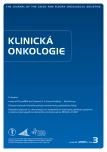Prognostic Survival Factors of Hepatocellular Carcinoma Treated with Transarterial Chemoembolization
Authors:
Tomáš Rohan 1; Michal Uher 2; Peter Matkulčík 1; Jan Zavadil 1; Lenka Ostřížková 3; Igor Kiss 4; Tomáš Andrašina 1; Vlastimil Válek 1
Authors place of work:
Klinika radiologie a nukleární medicíny LF MU a FN Brno2 Institut biostatistiky a analýz, LF MU Brno
1; Interní hematologická a onkologická klinika FN Brno4 Masarykův onkologický ústav, Brno
3
Published in the journal:
Klin Onkol 2020; 33(3): 214-219
Category:
Původní práce
doi:
https://doi.org/10.14735/amko2020214
Summary
Purpose: Identification of prognostic survival factors of hepatocellular carcinoma (HCC) treated with transarterial chemoembolization (TACE) in a single center in 2005–2018.
Background: Transarterial chemoembolization in hepatocellular carcinoma is indicated in Barcelona Liver Cancer Clinic (BLCC) stage B. This stage includes a very large group of patients unsuitable for curative treatment, who are in a good clinical condition and do not show extra-hepatic spread. The aim of this retrospective analysis is to identify factors influencing patient survival and to divide the patients into subgroups based on these risk factors.
Materials and methods: All patients with HCC indicated for TACE in complex oncological center in 2005–2018 were included in the analysis. The survival rates from the 1st TACE were evaluated in relation to HCC on computed tomography/magnetic resonance prior to the 1st TACE (size of the biggest lesion, single/multiple lesions, unilobar/bilobar involvement), presence and severity of liver disease (cirrhosis, Child-Pugh, portal vein thrombosis) and a combination of other invasive treatment (resection, percutaneous ablation) (single and multivariate analysis). The survival of HCC patients was compared according to the year of the diagnosis and the year of the 1st TACE (log-rank test).
Results: Out of 382 patients, 157 (29 women) of them were treated with TACE (540 TACEs in total, median 3 TACEs per patient). The most important risk factors for survival were the presence of portal vein thrombosis (hazard ratio (HR) = 3.279), bilobar involvement (HR = 2.257), lesion size (HR = 1.125/cm) and Child-Pugh B in chronic liver disease (HR = 1.922). Based on these risk factors, the patients were divided into 3 prognostic groups with different median survival (52.1 vs. 21.5 vs. 9.0 months).
Conclusion: Based on the retrospective analysis, predictive factors of HCC survival after TACE were identified and the patients were divided into 3 prognostic groups based on these factors.
Keywords:
hepatocellular carcinoma – Survival analysis – transarterial chemoembolization – risk factors
Zdroje
1. Galle PR, Forner A, Llovet JM et al. EASL clinical practice guidelines: management of hepatocellular carcinoma. J Hepatol 2018; 69 (1): 182–236. doi: 10.1016/j.jhep.2018.03.019.
2. Horikawa M, Miyayama S, Irie T et al. Development of conventional transarterial chemoembolization for hepatocellular carcinomas in japan: historical, strategic, and technical review. Am J Roentgenol 2015; 205 (4): 764–773. doi: 10.2214/AJR.15.14825.
3. Kudo M. Management of hepatocellular carcinoma in Japan as a world-leading model. Liver Cancer 2018; 7 (2): 134–47. doi: 10.1159/000484619.
4. Facciorusso A. Drug-eluting beads transarterial chemoembolization for hepatocellular carcinoma: Current state of the art. World J Gastroenterol 2018; 24 (2): 161–169. doi: 10.3748/wjg.v24.i2.161.
5. Wang Q, Xia D, Bai W et al. Development of a prognostic score for recommended TACE candidates with hepatocellular carcinoma: A multicentre observational study. J Hepatol. 2019; 70 (5): 893–903. doi: 10.1016/j.jhep.2019.01.013.
6. Sieghart W, Hucke F, Peck-Radosavljevic M. Transarterial chemoembolization: Modalities, indication, and patient selection. J Hepatol 2015; 62 (5): 1187–1195. doi: 10.1016/j.jhep.2015.02.010.
7. Kadalayil L, Benini R, Pallan L et al. A simple prognostic scoring system for patients receiving transarterial embolisation for hepatocellular cancer. Ann Oncol 2013; 24 (10): 2565–2570. doi: 10.1093/annonc/mdt247.
8. Raoul JL, Forner A, Bolondi L et al. Updated use of TACE for hepatocellular carcinoma treatment: How and when to use it based on clinical evidence. Cancer Treat Rev 2019; 72: 28–36. doi: 10.1016/j.ctrv.2018.11.002.
9. Katagiri S, Yamamoto M. Multidisciplinary treatments for hepatocellular carcinoma with major portal vein tumor thrombus. Surg Today 2014; 44 (2): 219–226. doi: 10.1007/s00595-013-0585-6.
10. EASL-EORTC Clinical Practice Guidelines: Management of hepatocellular carcinoma. [online]. Available from https: //www.journal-of-hepatology.eu/article/S0168-8278 (11) 00873-7/fulltext.
11. Iwazawa J, Ohue S, Hashimoto N et al. Survival after C-arm CT-assisted chemoembolization of unresectable hepatocellular carcinoma. Eur J Radiol 2012; 81 (12): 3985–3992. doi: 10.1016/j.ejrad.2012.08.012.
12. Rohan T, Andrašina T, Uher M et al. Chemoembolization for treatment of hepatocellular carcinoma – national registry-based analysis. Klin Onkol 2019; 32 (Suppl 1): S160–S163.
Štítky
Detská onkológia Chirurgia všeobecná OnkológiaČlánok vyšiel v časopise
Klinická onkologie

2020 Číslo 3
- Metamizol jako analgetikum první volby: kdy, pro koho, jak a proč?
- Nejasný stín na plicích – kazuistika
- Fixní kombinace paracetamol/kodein nabízí synergické analgetické účinky
- Tramadol a paracetamol v tlumení poextrakční bolesti
- Antidepresivní efekt kombinovaného analgetika tramadolu s paracetamolem
Najčítanejšie v tomto čísle
- Hladiny NT-proBNP a troponínu T u onkologických pacientov – stručný prehľad
- Kompletná odpoveď na chemoterapiu pri metastatickom karcinóme pankreasu spojenom s dvojitou heterozygotnou zárodočnou mutáciou génov BRCA2 a CHEK2 – kazuistika
- Význam aberantně aktivované dráhy Hedgehog/Gli pro nádorovou progresi
- Hodnotenie kvality života u pacientov s nádormi hlavy a krku
